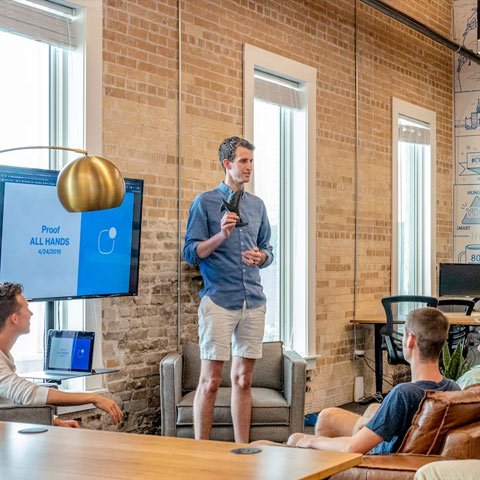News in 2017 - A Digital Marketing Perspective

In the UK, news consumption online has grown incredibly over the past year and continues to do so in 2017. This is largely due to key events, namely Brexit and Trump, which have dominated the headlines.
We are not only consuming more news across broader sources, we are also thinking about and questioning the role that news providers play.
In this report, we look at key online trends and takeaways for news providers in 2017. We go back to basics, including knowing what to write about, when to publish and who to target, and provide tactics to increase and retain online market share.
Get the downloadBelow is an excerpt of "News in 2017 - A Digital Marketing Perspective". To get your free download, and unlimited access to the whole of bizibl.com, simply log in or join free. |

|
1. What Do People Read And When?
In this section, we look at how news topics change, depending on day of the week and hour of the day. We also see how breaking news disrupts typical hourly patterns, and why this matters to publishers.
Day of the week, hour of the day and topic need to be considered when determining the best time to publish articles.
To illustrate this, we analysed the top 5 news topics on the weekday, compared to the top 5 news topics at the weekend.
Politics has dominated the headlines and will continue to do so over the course of the year. In particular, Trump and Brexit accounted for 5 out of the top 10 read articles, based on total page views over the end of January to end of February 2017.
News about the UK eclipses all other topics, peaking at 4-6pm on weekdays, compared to 12pm-7pm on weekends. US news also increases on the weekend, particularly from 4pm onwards.
Our hourly news consumption also shifts with breaking stories. For instance, news patterns changed dramatically on the day of Trump’s state visit debate (on the 20th of February). Whilst news consumption typically peaks in the evening, on the day of the debate, articles with “Trump” in its headlines saw multiple spikes.
Although the Daily Mail received the highest traffic volume out of all online newspapers, the Guardian won share over their Trump coverage in the early morning and late evening. This was predominantly the result of two articles - Trump’s Swedish terror attack claim and state visit debate.
2. What Should You Write About?
Search terms provide a rich source of inspiration for publishers, representing people’s “top of mind” thoughts and queries.
News providers need to keep a close eye on fast moving terms to get the first mover advantage.
For example, search was expertly used by The Independent to win the lion’s share of traffic from the Nokia 3310 relaunch.
Online buzz around the revived Nokia 3310 first came about almost 2 weeks before its official announcement (at the Mobile World Congress on the 27th February).
If we dig deeper into the search variations around “Nokia 3310” during this week, terms with high organic rates also included “relaunch”, “new” and “price”.
Looking at the downstream traffic from these searches, The Independent had gained the highest share in the weeks of the 18th and 25th of February. Within these weeks, the publication used the top searched for terms with high organic rates, such as “relaunch” and “new” in their headlines to gain traffic. Other publishers, such as The Sun, Telegraph and Tech Radar, eventually caught up with their coverage in the week of the 25th.
3. How Long does an Article "Live" For?
The “life” of an article, i.e. how long a single piece of content is read for, differs by mode and topic. Publishers need to track their article duration to optimise content frequency.
It’s no surprise that some news topics resonates more than others. The question is, by how much?
Knowing how frequent content needs to be written and refreshed is critical for all news publications.
By looking at the BBC News, which accounted for 9% of all traffic to News & Media sites in 2016, we can uncover some of these insights.
Standard news articles, defined as content accessed through web browsers on desktop and tablets, typically have a 2-day life on the BBC. Yet, popularity on Day 2 varies by topic – from UK news (19% on Day 2) to US news (34% on Day 2).
Whereas, mobile-optimised content has a significantly shorter life of only 1-day, especially for topics related to Europe, Middle East and US news.
Live news, which are feeds that get refreshed and updated as breaking news and events unfold, has a more varied life depending on topic. Consumption of news related to the Middle East typically peaks and lasts for one day, compared to live news related to Europe which lasts for up to 3 days.
4. Who Reads Your News?
Key events, such as Trump’s inauguration, have helped blur the lines between audiences of traditional right and left-leaning publications.
Audiences that consume online news tend to shift more regularly than audiences of offline news.
For example, people who associate with liberal politics are probably not likely to purchase The Sun in print format, but would still read online news from a range of right and left sources.
Key political events, particularly coverage on Trump, have further blurred the lines across online audiences. For instance, Trump’s inauguration has potentially impacted where people read the news.
Comparing the month before and after Trump’s inauguration, left-leaning newspapers such as The Guardian and The Independent have gained readers from traditional right-leaning tabloids, such as The Sun, Express and Daily Mail.
News providers need to keep track of these audience shifts, and understand who have gained (or lost) and why. In the case for The Independent, this shift came from millennials living in the Yorkshire, Wales & South East regions. For a publication who normally attracts an older demographic, The Independent could then try to understand what types of content drew this particular audience and how to retain them.
5. What Drives Engagement and Subscription?
For subscription-based publications, like The Times, human interest stories drive higher engagement than general news.
News providers also need visibility over the types of content that leads to greater engagement.
This can be tracked through various metrics, such as page views, article life and registrations or subscriptions (relevant for paywall publications).
For instance, for The Times, human interest stories drove significantly more registrations (40%), compared to general news and reporting on events (27%), in the three months leading to January 2017. These stories included unique content to The Times, such as interviews with UK political figures, sports stars and everyday people with extraordinary events.
Trump also seems to be a winning topic for The Times (also for The New York Times – despite controversy with the US president), resulting in the most registrations at 14% compared to other content topics.
Key Takeaways For News and Publishing Companies
- Optimise when articles are published by considering day of week, hour and topic
- Track the lifetime of articles to understand frequency (how often content needs to be produced) and duration (how long an article stays featured on a website).
- Use fast moving search terms as a source of content inspiration and replicate top keywords to improve click through.
- Keep track o your online audience and crossover with competitors.
- Understand what type of content generates engagement, to differentiate your publication and retain new audiences.
Want more like this?
Want more like this?
Insight delivered to your inbox
Keep up to date with our free email. Hand picked whitepapers and posts from our blog, as well as exclusive videos and webinar invitations keep our Users one step ahead.
By clicking 'SIGN UP', you agree to our Terms of Use and Privacy Policy


By clicking 'SIGN UP', you agree to our Terms of Use and Privacy Policy









